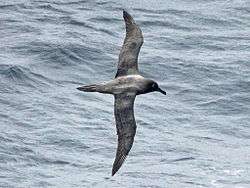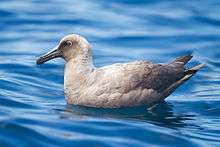Sooty albatross
| Sooty albatross | |
|---|---|
 | |
| Scientific classification | |
| Kingdom: | Animalia |
| Phylum: | Chordata |
| Class: | Aves |
| Order: | Procellariiformes |
| Family: | Diomedeidae |
| Genus: | Phoebetria |
| Species: | P. fusca |
| Binomial name | |
| Phoebetria fusca (Hilsenberg, 1822)[2] | |


The sooty albatross, dark-mantled sooty albatross or dark-mantled albatross,[3] (Phoebetria fusca), is a species of bird in the albatross family. They breed on sub-Antarctic islands and range at sea across the Southern Ocean from South America to Australia.[4]
Taxonomy
Sooty albatrosses are a type of albatross that belong to Diomedeidae family and come from the Procellariiformes order, along with shearwaters, fulmars, storm petrels, and diving petrels. They share certain identifying features. First, they have nasal passages that attach to the upper bill called naricorns. Although the nostrils on the albatross are on the sides of the bill. The bills of Procellariiformes are also unique in that they are split into between 7 and 9 horny plates. Finally, they produce a stomach oil made up of wax esters and triglycerides that is stored in the proventriculus. This is used against predators as well as an energy rich food source for chicks and for the adults during their long flights.[5] They also have a salt gland that is situated above the nasal passage and helps desalinate their bodies, due to the high amount of ocean water that they imbibe. It excretes a high saline solution from their nose.[6]
Description
The sooty albatross is a medium-sized albatross and measures about 85 cm (33 in),[7] with a 2 m (6.6 ft) wingspan.[8] Adult body mass ranges from 2.1 to 3.4 kg (4.6 to 7.5 lb).[9] It is sooty-brown[8] with darker shading on the sides of its head. It has a white crescent above and behind its eye. Its bill is black with an orange or yellow sulcus. The tail of this albatross is wide diamond-shaped. Juveniles are similar to adults, although they can have paler feathers on the nape and upper back, possibly creating confusion with light-mantled albatross.[7]
Behavior
Feeding
Their diet consists of squid,[8] crustaceans, cephalopods, fish, and carrion.[7]
Reproduction
The sooty albatross is a colonial bird; however not to the degree of other albatrosses, as their colonies usually consist of 50 to 60 pair. They will build their nests on cliffs and steep slopes. Whereas they can mate annually they only do so biennially.[7]
Range and habitat
This albatross nests on islands in the southern Atlantic Ocean (Gough Island and the Tristan da Cunha group) and Indian Ocean (Prince Edward Island, Marion Island, the Crozet Islands, Amsterdam Island, and Kerguelen Islands).[7] They forage in both oceans north to about 30°S.[10]
Conservation
The IUCN ranks the sooty albatross as endangered[1] with an occurrence range of 40,800,000 km2 (15,800,000 sq mi) and a breeding range of 1,900 km2 (730 sq mi). A 1998 estimate place the population at 42,000 adult birds.
Populations have been shrinking 75% over the last 90 years; although the rate of reduction has recently slowed. The 21st century has seen stable populations at Gough Island.[7]
This species is not overly affected by longline fisheries, but instead by domestic cats eating eggs and chicks on Amsterdam Island and the Kerguelen Islands. Avian cholera, pasteurellosis, and erysipelas are major threats. Illegal poaching has nearly ceased.[7]
Studies and surveys are conducted to assist in slowing its demise. It is a protected species on the Tristan da Cunha group, Gough Island is a World Heritage Site, and Prince Edward Island, Gough Island, and Inaccessible Island in the Tristan da Cunha group are protected nature preserves. Also, in 2007, the Crozet Islands, Amsterdam Island, and the Kerguelen Islands were declared nature preserves.[7]
| Breeding Location | Breeding Pair | Trend |
| Gough Island | 5,000 | – 50% over 28 years |
| Tristan da Cunha | 4,125 to 5,250 | Unknown |
| Crozet Islands | 2,620 | −58% between 1980 and 1995 (Possession Island only) |
| Prince Edward Island and Marion Island | 1,720 | −25% between 1990 and 1998 (Marion Island only) |
| Kerguelen Islands | <5 | Unknown |
| Amsterdam Island | 300 to 400 | Unknown |
| Total | 12,500 to 19,000 | -75% over 90 years |
Footnotes
- 1 2 BirdLife International (2012). "Phoebetria fusca". IUCN Red List of Threatened Species. Version 2013.2. International Union for Conservation of Nature. Retrieved 26 November 2013.
- ↑ Brands, S. (2008)
- ↑ BirdLife International (2008b)
- ↑ Brooke, M. (2004)
- ↑ Double, M. C. (2003)
- ↑ Ehrlich, Paul R. (1988)
- 1 2 3 4 5 6 7 8 9 BirdLife International (2008a)
- 1 2 3 Trewby, M. (2002)
- ↑ CRC Handbook of Avian Body Masses by John B. Dunning Jr. (Editor). CRC Press (1992), ISBN 978-0-8493-4258-5.
- ↑ Clements, J. (2007)
References
- BirdLife International (2008a). "Sooty Albatross – BirdLife Species Factsheet". Data Zone. Retrieved 12 Mar 2009.
- BirdLife International (2008b). "The BirdLife checklist of the birds of the world, with conservation status and taxonomic sources." (xls). Retrieved 12 Mar 2009.
- Brands, Sheila (14 Aug 2008). "Systema Naturae 2000 / Classification – Genus Phoebetria –". Project: The Taxonomicon. Retrieved 22 Feb 2009.
- Brooke, M. (2004). "Procellariidae". Albatrosses And Petrels Across The World. Oxford, UK: Oxford University Press. ISBN 0-19-850125-0.
- Clements, James (2007). The Clements Checklist of the Birds of the World (6 ed.). Ithaca, NY: Cornell University Press. ISBN 978-0-8014-4501-9.
- Double, M. C. (2003). "Procellariiformes (Tubenosed Seabirds)". In Hutchins, Michael; Jackson, Jerome A.; Bock, Walter J.; Olendorf, Donna. Grzimek's Animal Life Encyclopedia. 8 Birds I Tinamous and Ratites to Hoatzins. Joseph E. Trumpey, Chief Scientific Illustrator (2nd ed.). Farmington Hills, MI: Gale Group. pp. 107–111. ISBN 0-7876-5784-0.
- Ehrlich, Paul R.; Dobkin, David, S.; Wheye, Darryl (1988). The Birders Handbook (First ed.). New York, NY: Simon & Schuster. pp. 29–31. ISBN 0-671-65989-8.
- Trewby, Mary (2002). Antarctica: an encyclopedia from Abbot Ice Shelf to zooplankton. Auckland, New Zealand: Firefly Books Ltd. p. 170. ISBN 1-55297-590-8.
| Wikispecies has information related to: Phoebetria fusca |
